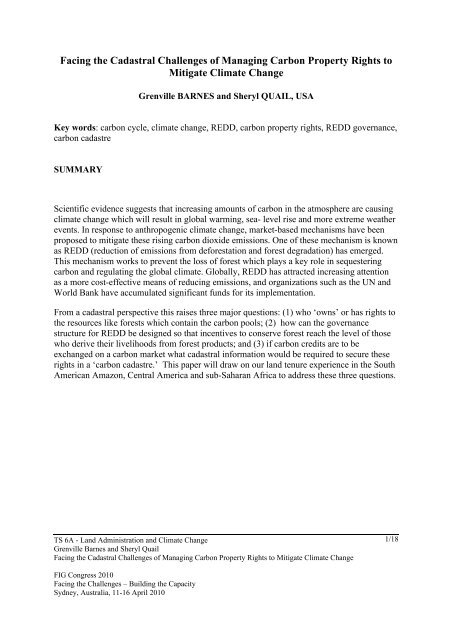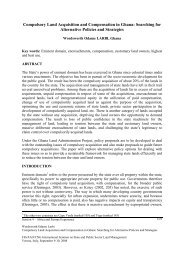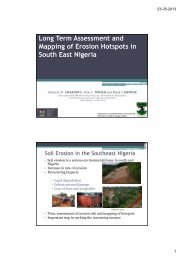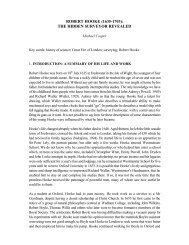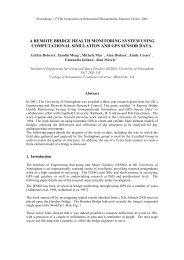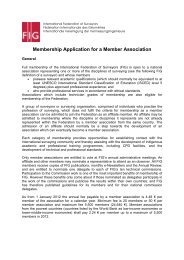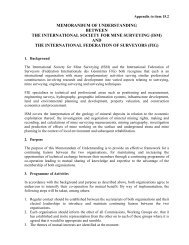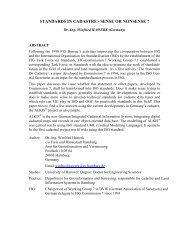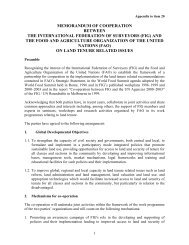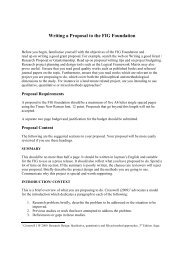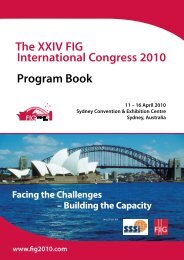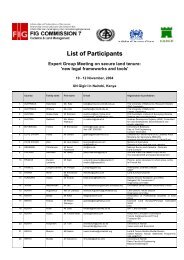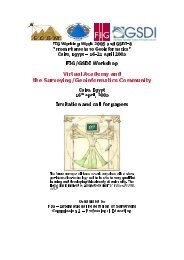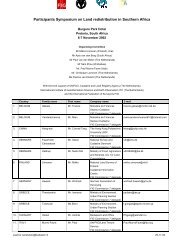Facing the Cadastral Challenges of Managing Carbon ... - FiG
Facing the Cadastral Challenges of Managing Carbon ... - FiG
Facing the Cadastral Challenges of Managing Carbon ... - FiG
Create successful ePaper yourself
Turn your PDF publications into a flip-book with our unique Google optimized e-Paper software.
<strong>Facing</strong> <strong>the</strong> <strong>Cadastral</strong> <strong>Challenges</strong> <strong>of</strong> <strong>Managing</strong> <strong>Carbon</strong> Property Rights to<br />
Mitigate Climate Change<br />
Grenville BARNES and Sheryl QUAIL, USA<br />
Key words: carbon cycle, climate change, REDD, carbon property rights, REDD governance,<br />
carbon cadastre<br />
SUMMARY<br />
Scientific evidence suggests that increasing amounts <strong>of</strong> carbon in <strong>the</strong> atmosphere are causing<br />
climate change which will result in global warming, sea- level rise and more extreme wea<strong>the</strong>r<br />
events. In response to anthropogenic climate change, market-based mechanisms have been<br />
proposed to mitigate <strong>the</strong>se rising carbon dioxide emissions. One <strong>of</strong> <strong>the</strong>se mechanism is known<br />
as REDD (reduction <strong>of</strong> emissions from deforestation and forest degradation) has emerged.<br />
This mechanism works to prevent <strong>the</strong> loss <strong>of</strong> forest which plays a key role in sequestering<br />
carbon and regulating <strong>the</strong> global climate. Globally, REDD has attracted increasing attention<br />
as a more cost-effective means <strong>of</strong> reducing emissions, and organizations such as <strong>the</strong> UN and<br />
World Bank have accumulated significant funds for its implementation.<br />
From a cadastral perspective this raises three major questions: (1) who ‘owns’ or has rights to<br />
<strong>the</strong> resources like forests which contain <strong>the</strong> carbon pools; (2) how can <strong>the</strong> governance<br />
structure for REDD be designed so that incentives to conserve forest reach <strong>the</strong> level <strong>of</strong> those<br />
who derive <strong>the</strong>ir livelihoods from forest products; and (3) if carbon credits are to be<br />
exchanged on a carbon market what cadastral information would be required to secure <strong>the</strong>se<br />
rights in a ‘carbon cadastre.’ This paper will draw on our land tenure experience in <strong>the</strong> South<br />
American Amazon, Central America and sub-Saharan Africa to address <strong>the</strong>se three questions.<br />
TS 6A - Land Administration and Climate Change<br />
Grenville Barnes and Sheryl Quail<br />
<strong>Facing</strong> <strong>the</strong> <strong>Cadastral</strong> <strong>Challenges</strong> <strong>of</strong> <strong>Managing</strong> <strong>Carbon</strong> Property Rights to Mitigate Climate Change<br />
1/18<br />
FIG Congress 2010<br />
<strong>Facing</strong> <strong>the</strong> <strong>Challenges</strong> – Building <strong>the</strong> Capacity<br />
Sydney, Australia, 11-16 April 2010
<strong>Facing</strong> <strong>the</strong> <strong>Cadastral</strong> <strong>Challenges</strong> <strong>of</strong> <strong>Managing</strong> <strong>Carbon</strong> Property Rights to<br />
Mitigate Climate Change<br />
INTRODUCTION<br />
Grenville BARNES and Sheryl QUAIL, USA<br />
Scientific evidence suggests that increasing amounts <strong>of</strong> carbon in <strong>the</strong> atmosphere are causing<br />
climate change which will result in global warming, sea- level rise and more extreme wea<strong>the</strong>r<br />
events. In this paper we first summarize carbon fluxes, reservoirs and residence times and<br />
discuss how perturbations to <strong>the</strong> carbon cycle are altering climate regimes due to a number <strong>of</strong><br />
factors, including human use <strong>of</strong> fossil fuels, land use change and unprecedented deforestation.<br />
The consequences <strong>of</strong> rising anthropogenic emissions is already underway with unprecidented<br />
predicted costs to <strong>the</strong> global economy and loss <strong>of</strong> ecosystem functioning and life.<br />
Market based mechanisms have been proposed to mitigate rising carbon dioxide emissions<br />
using a cap-n-trade system. The cap-n-trade system was introduced in <strong>the</strong> United States in <strong>the</strong><br />
1980s to abate acid rain caused by sulfur dioxide emissions from <strong>the</strong> combustion <strong>of</strong> coal. This<br />
system effectively eliminated acidity in lakes and forests in <strong>the</strong> eastern U.S and western<br />
Europe. <strong>Carbon</strong> dioxide, by contrast, has more sources and sinks making abatement more<br />
challenging and <strong>the</strong> defining <strong>of</strong> property rights more ambiguous. As forests are a major sink<br />
and source <strong>of</strong> carbon, various strategies have been proposed to reduce emissions from<br />
deforestation and forest degradation (REDD), as well as to augment existing forests stocks<br />
through replanting and restoration.<br />
Land tenure, and more specifically property rights to carbon stocks, is increasingly recognized<br />
as an integral part <strong>of</strong> <strong>the</strong> climate change debate. Property rights issues have been raised with<br />
respect to: communally held land (Randrianarisoa, Vitale and Pandya 2008) including<br />
indigenous lands Griffiths 2007); insecure tenure leading to deforestation (Porrua Garcia-<br />
Guerrero 2008; OCC 2008; Parker et al 2008 ); legal conceptions <strong>of</strong> a carbon property right<br />
(Boydell, Sheehan and Prior 2008; Takacs 2009; Quan and Dyer 2008) and <strong>the</strong> need to<br />
clarify who will be <strong>the</strong> beneficiaries <strong>of</strong> carbon payments through mechanisms such as REDD<br />
(Forest Dialog 2008). Property rights to forests and/or carbon have been recognized as a key<br />
issue in almost all <strong>the</strong> major climate change reports, such as <strong>the</strong> Eliasch (OCC 2008) and<br />
Stern Reports (Stern etal 2007) and <strong>the</strong> various IPCC reports (IPCC 2003; IPCC 2007).<br />
In this paper we examine <strong>the</strong> complex bundle <strong>of</strong> rights in <strong>the</strong> Peruvian Amazon and make <strong>the</strong><br />
case for focusing initially on forest carbon property rights. We explore <strong>the</strong> concept <strong>of</strong> a<br />
carbon conservancy as a meso-level organization for holding carbon property rights. Finally,<br />
we propose a governance structure which makes use <strong>of</strong> a carbon cadastre.<br />
THE CARBON CYCLE<br />
Understanding <strong>the</strong> nature and characteristics <strong>of</strong> a fugitive gas is a necessary first step in<br />
examining carbon within a property framework. <strong>Carbon</strong> dioxide is most commonly emitted<br />
to <strong>the</strong> atmosphere by <strong>the</strong> combustion <strong>of</strong> coal for electrical power; <strong>the</strong> burning <strong>of</strong> petroleum<br />
TS 6A - Land Administration and Climate Change<br />
Grenville Barnes and Sheryl Quail<br />
<strong>Facing</strong> <strong>the</strong> <strong>Cadastral</strong> <strong>Challenges</strong> <strong>of</strong> <strong>Managing</strong> <strong>Carbon</strong> Property Rights to Mitigate Climate Change<br />
2/18<br />
FIG Congress 2010<br />
<strong>Facing</strong> <strong>the</strong> <strong>Challenges</strong> – Building <strong>the</strong> Capacity<br />
Sydney, Australia, 11-16 April 2010
products for transportation; <strong>the</strong> removal <strong>of</strong> carbon during <strong>the</strong> production <strong>of</strong> cement; and <strong>the</strong><br />
clearing <strong>of</strong> forests typically for agricultural expansion. Once combusted, oxidized carbon<br />
enters <strong>the</strong> atmosphere where it is sequestered by plants, via photosyn<strong>the</strong>sis, or by <strong>the</strong> oceans<br />
where it resides as a carbonate or bicarbonate ion. Should <strong>the</strong> molecule be sequestered by a<br />
tree through a leaf stomata, it will be incorporated into a growing stem and exploited to fuel<br />
<strong>the</strong> syn<strong>the</strong>sis <strong>of</strong> energy molecules to carry out various cellular functions.<br />
This tree may be set on fire to clear land for pasture, bio-fuels or food crop farm, immediately<br />
liberating <strong>the</strong> carbon in <strong>the</strong> stem and causing <strong>the</strong> carbon to re-enter atmospheric circulation. If<br />
<strong>the</strong> tree is harvested for timber, <strong>the</strong> wood will decay and return its carbon to <strong>the</strong> atmosphere at<br />
a slow, steady rate, although this varies considerably depending on <strong>the</strong> region. The root mass<br />
left below ground will decompose and <strong>the</strong> resulting carbon will eventually migrate to rivers<br />
and oceans. Most importantly, <strong>the</strong> growing tree will no longer exist to grow leaves and<br />
biomass to sequester carbon. Aged leaves will no longer fall to <strong>the</strong> ground to form soil<br />
carbon. In summary, unless <strong>the</strong> carbon is locked in forest biomass over <strong>the</strong> long term, it will<br />
contribute to <strong>the</strong> growing greenhouse gases in <strong>the</strong> atmosphere with long-term climate change<br />
consequences.<br />
The first measurements <strong>of</strong> atmospheric carbon were taken by Charles Keeling in 1958 in<br />
Mauna Loa, Hawaii and at <strong>the</strong> South Pole (Keeling et al, 2001; Houghton, 2007). O<strong>the</strong>r<br />
methods exist for reconstructing pre-industrial (1750) carbon scenarios, such as <strong>the</strong><br />
measurement <strong>of</strong> tree rings to compare annual growth rates, corals to determine <strong>the</strong> amount <strong>of</strong><br />
oxygen atmospheric isotopes, or <strong>the</strong> measurement <strong>of</strong> CO2 bubbles at <strong>the</strong> poles over geologic<br />
times. From this, it has been estimated that pre-industrial carbon dioxide concentrations<br />
ranged between 275 and 285 ppm. Today <strong>the</strong>re are roughly 100 monitoring stations collecting<br />
CO 2 data for a global data set (Masarie & Tans, 1995; Houghton, 2007).<br />
The IPCC (2007) currently estimates anthropogenic CO2 emissions at 32 billion tons per<br />
year, <strong>of</strong> which 47% remains in <strong>the</strong> atmosphere until sequestered over longer periods <strong>of</strong> time.<br />
Approximately 20% is sequestered by oceans; and 15% by terrestrial systems. A recent study<br />
has found that tropical forests alone sequester 18% <strong>of</strong> anthropogenic carbon, representing<br />
one-half <strong>of</strong> <strong>the</strong> terrestrial carbon pool (Lewis et al 2009).<br />
Terrestrial biomass and <strong>the</strong> oceans are transient reservoirs for CO 2 and serve as stopping<br />
points before a carbon molecule reaches its final destination in carbonate rocks or under<br />
buried sediments. The amount <strong>of</strong> time a molecule resides in a particular reservoir before<br />
transferring to <strong>the</strong> next varies for CO 2 . After roughly 300 years, 70-85% <strong>of</strong> CO 2 will have<br />
entered <strong>the</strong> oceans or terrestrial biomass, and even after 100,000 years, a small amount (3-7%)<br />
<strong>of</strong> fossil fuel carbon may remain in <strong>the</strong> atmosphere (Archer 2005).<br />
Of all <strong>the</strong> major terrestrial biomes, forests, especially in <strong>the</strong> tropics, make <strong>the</strong> greatest<br />
contribution to global climate regulation. They store 86% <strong>of</strong> <strong>the</strong> world’s above-ground<br />
biomass and 73% <strong>of</strong> <strong>the</strong> world’s soil carbon (Sedjo, 1993). Tropical forests comprise 47% <strong>of</strong><br />
<strong>the</strong> world’s forests; <strong>of</strong> this, 50% are in South America, 30% in Africa, and 20% in Asia. A 40-<br />
year study <strong>of</strong> forests in Africa, South America and Asia found that tropical forests sequester<br />
TS 6A - Land Administration and Climate Change<br />
Grenville Barnes and Sheryl Quail<br />
<strong>Facing</strong> <strong>the</strong> <strong>Cadastral</strong> <strong>Challenges</strong> <strong>of</strong> <strong>Managing</strong> <strong>Carbon</strong> Property Rights to Mitigate Climate Change<br />
3/18<br />
FIG Congress 2010<br />
<strong>Facing</strong> <strong>the</strong> <strong>Challenges</strong> – Building <strong>the</strong> Capacity<br />
Sydney, Australia, 11-16 April 2010
oughly 18% <strong>of</strong> carbon emitted from <strong>the</strong> burning <strong>of</strong> fossil fuels (Lewis et al, 2009). Tropical<br />
forests store approximately 50% more carbon than forests outside <strong>the</strong> tropics, due to <strong>the</strong>ir<br />
longer growing season and higher growth rates (FAO, 2005).<br />
CARBON AND GLOBAL CLIMATE CHANGE<br />
Anthropogenic climate change is well underway and its impacts to humans and ecosystems is<br />
evident. As <strong>the</strong> largest sink <strong>of</strong> carbon dioxide, oceans are bearing <strong>the</strong> brunt <strong>of</strong> climate change<br />
with significant impacts to human populations, climate systems and marine ecosystems.<br />
Eleven <strong>of</strong> <strong>the</strong> last twelve years are <strong>the</strong> warmest on record since 1850, and a total increase <strong>of</strong><br />
0.76 degrees C since this date. Oceans absorb 80% <strong>of</strong> atmospheric heating, which has led to<br />
<strong>the</strong> <strong>the</strong>rmal expansion <strong>of</strong> ocean water and sea level rise. From 1961 to 2003, global average<br />
sea level rose at an average rate <strong>of</strong> 1.8 mm per year; from 1993 this rate increased to<br />
approximately 3.1 mm. Because so much uncertainty surrounds contributions to sea level rise<br />
from ice sheet loss, <strong>the</strong>se are not incorporated into climate models. As a result, predictions <strong>of</strong><br />
future sea level rise <strong>of</strong> upwards <strong>of</strong> one meter are conservative. Roughly ten percent <strong>of</strong> <strong>the</strong><br />
global population or 600 million people reside in coastal areas and are especially vulnerable<br />
to a rise in sea level (IPCC, 2007).<br />
The impacts <strong>of</strong> a warming earth are manifesting in a multitude <strong>of</strong> ways with new<br />
consequences arising all <strong>the</strong> time. Shifts in ranges <strong>of</strong> rainfall and temperature regimes are<br />
occurring with concurrent shifts in species’ ranges, leaf-unfolding, bird migration and egglaying.<br />
Increased ice melt and corresponding enlargement <strong>of</strong> glacial lakes, growing instability<br />
<strong>of</strong> permafrost, and changes in polar ecosystems and food webs are occurring. Growing<br />
seasons are leng<strong>the</strong>ning and earlier greening in vegetation transpiring. The oceanic<br />
<strong>the</strong>rmocline is deepening with implications for nutrient upwelling. Range changes are also<br />
occurring in lakes and rivers in response to warmer temperatures. Perhaps most dire <strong>of</strong> all is<br />
<strong>the</strong> observed drop in pH in <strong>the</strong> ocean, which can inhibit <strong>the</strong> <strong>the</strong> formation <strong>of</strong> calcareous shells<br />
for corals, molluscs, pteropod snails, and various phytoplankton species that form <strong>the</strong> bottom<br />
<strong>of</strong> <strong>the</strong> food marine food chain (IPCC, 2007).<br />
*With growing evidence <strong>of</strong> anthropogenic climate change, it is important to identify <strong>the</strong><br />
sources <strong>of</strong> emissions, as well as sinks. The largest source <strong>of</strong> carbon emissions has been from<br />
fossil fuels followed by land use change stemming predominantly from <strong>the</strong> conversion <strong>of</strong><br />
forests to agriculture. Drivers <strong>of</strong> land-use change include agricultural expansion, urbanization,<br />
population increase, affluence, and technological change. Deforestation, or <strong>the</strong> conversion <strong>of</strong><br />
forests to agricultural land, accounts for <strong>the</strong> loss <strong>of</strong> 13 million hectares each year (FAO,<br />
2005). While forest degradation does not result in <strong>the</strong> total removal <strong>of</strong> forest, it does reduce<br />
ecosystem functioning and change in species composition, and is widespread in <strong>the</strong> tropics<br />
(Sasaski & Putz, 2009). Deforestation is estimated to have released 1.1 to 2.2 PgC/year<br />
(Houghton, 2007; Achard et al, 2004; Gullison et al, 2007), with degradation estimated to<br />
have emitted <strong>the</strong> same amount (Gaston et al, 1998). South America and Africa have suffered<br />
<strong>the</strong> largest net loss <strong>of</strong> forests, estimated at 4.3 and 4.0 million hectares respectively from 2000<br />
to 2005 (FAO, 2005).<br />
TS 6A - Land Administration and Climate Change<br />
Grenville Barnes and Sheryl Quail<br />
<strong>Facing</strong> <strong>the</strong> <strong>Cadastral</strong> <strong>Challenges</strong> <strong>of</strong> <strong>Managing</strong> <strong>Carbon</strong> Property Rights to Mitigate Climate Change<br />
4/18<br />
FIG Congress 2010<br />
<strong>Facing</strong> <strong>the</strong> <strong>Challenges</strong> – Building <strong>the</strong> Capacity<br />
Sydney, Australia, 11-16 April 2010
REDD<br />
Inaction on reducing greenhouse gases is predicted to cost upwards <strong>of</strong> 20% <strong>of</strong> global GDP<br />
with <strong>the</strong> greatest impacts on <strong>the</strong> world’s most economically vulnerable. The current level <strong>of</strong><br />
atmospheric carbon is 430 ppm and is rising roughly 2 ppm per year; at this rate, greenhouse<br />
gas levels will be double that <strong>of</strong> pre-industrial concentrations by 2035. To stabilize carbon<br />
dioxide between 450 and 550 ppm it is estimated to cost approximately 1% <strong>of</strong> GDP (Stern,<br />
2007). In terms <strong>of</strong> social benefit, <strong>the</strong> cost <strong>of</strong> abatement far outweighs <strong>the</strong> cost <strong>of</strong> climate<br />
inaction. With government regulation unpalatable to business and inefficient in <strong>the</strong> eyes <strong>of</strong><br />
many economists, market-based mechanisms have been proposed to mitigate <strong>the</strong>se rising<br />
carbon dioxide emissions.<br />
The United Nations Framework Convention on Climate Change (UNFCCC) created <strong>the</strong><br />
Kyoto Protocol in 1997 that bound industrialized signatories (Annex countries) to emissions<br />
reductions <strong>of</strong> five greenhouse gases. In 2005, <strong>the</strong> European Emissions Trading Scheme (EU<br />
ETS) was initiated as a market trading mechanism, whereby large-scale emitters such as<br />
power plants could purchase pollution credits, which are <strong>the</strong>n used to invest in carbon<br />
reduction projects elsewhere. Under a cap-and-trade system, a limit or allowance is set on <strong>the</strong><br />
amount <strong>of</strong> carbon a company can emit. If <strong>the</strong> allowance is exceeded, <strong>the</strong> company <strong>the</strong>n buys<br />
an allowance or credit elsewhere, or faces heavy fines. The seller, in turn, is rewarded for<br />
having reduced emissions. Projects can range from energy conservation programs in<br />
commercial and industrial facilities to methane capture at landfill sites to investment in<br />
alternative energy sources. O<strong>the</strong>r trading regimes emerged later under <strong>the</strong> compliance markets<br />
and include New South Wales and UK ETS.<br />
Kyoto signatories from less industrialized or non-Annex countries can be recipients <strong>of</strong> carbon<br />
reduction projects through <strong>the</strong> Clean Development Mechanism (CDM). Article 12.2 <strong>of</strong> <strong>the</strong><br />
Kyoto Protocol stipulates that non-Annex countries should be assisted with sustainable<br />
development with special emphasis on less advantaged populations. Since approximately 20%<br />
<strong>of</strong> global carbon emissions stem from loss <strong>of</strong> forests, which is greater than total emissions<br />
from <strong>the</strong> transportation sector, strategies to mitigate forest loss from non-Annex countries<br />
plays an integral role in climate stabilization (IPCC, 2007). The Stern Report (2007) also<br />
identified <strong>the</strong> forestry sector as one <strong>the</strong> more cost effective abatement strategies. In o<strong>the</strong>r<br />
words, compared to <strong>the</strong> development <strong>of</strong> costly pollution control devices in <strong>the</strong> industrial<br />
sector, forests represent <strong>the</strong> lowest hanging fruit in <strong>the</strong> range <strong>of</strong> options for reducing carbon<br />
emissions.<br />
The EU ETS does not allow carbon forestry projects to be transacted directly between EU<br />
ETS investors and project recipients. For this reason project development through <strong>the</strong> CDM is<br />
channeled through <strong>the</strong> World Bank and UN. At this time only reforestation and afforestation<br />
(A/R) projects are allowed, but because <strong>of</strong> stringent CDM project development guidelines and<br />
higher transaction costs, most A/R projects have occurred through voluntary markets. These<br />
markets comprise <strong>the</strong> Chicago Climate Exchange (CCX) and <strong>the</strong> newly emerged Regional<br />
Greenhouse Gas Initiative (RGGI). Additionally, approximately 90 independent retail<br />
companies market 'charismatic carbon' projects in <strong>the</strong> forestry sector that <strong>of</strong>fset emissions for<br />
TS 6A - Land Administration and Climate Change<br />
Grenville Barnes and Sheryl Quail<br />
<strong>Facing</strong> <strong>the</strong> <strong>Cadastral</strong> <strong>Challenges</strong> <strong>of</strong> <strong>Managing</strong> <strong>Carbon</strong> Property Rights to Mitigate Climate Change<br />
5/18<br />
FIG Congress 2010<br />
<strong>Facing</strong> <strong>the</strong> <strong>Challenges</strong> – Building <strong>the</strong> Capacity<br />
Sydney, Australia, 11-16 April 2010
various corporations interested in green imaging or individual consumers who wish to <strong>of</strong>fset<br />
activities such as airplane travel. Such projects utilize any number <strong>of</strong> existing standards for<br />
project design and implementation (Hamilton et al, 2008).<br />
The value <strong>of</strong> <strong>the</strong> formal carbon markets has achieved momentous growth every year – rising<br />
steadily from $10 billion in 2005 to $117 billion in 2008 (World Bank 2009). Of this, <strong>the</strong><br />
voluntary CCX and Over <strong>the</strong> Counter (OTC) trades, which include companies that <strong>of</strong>fset<br />
emissions for corporations and individuals, captured $99 million in 2006, $335 million in<br />
2007, and $705 million in 2008 (Ecosystem Marketplace 2009). Unfortunately, <strong>the</strong> fantastic<br />
growth in <strong>the</strong> carbon markets has been constrained by <strong>the</strong> global economic downturn and<br />
declining industrial production, causing <strong>the</strong> price <strong>of</strong> carbon to collapse. Never<strong>the</strong>less, <strong>the</strong><br />
carbon market is predicted to rebound and voluntary markets to grow to $50 billion by 2012<br />
(Phillips and Razzuk 2007).<br />
Despite enormous sums <strong>of</strong> money transacted for emissions reductions, forests have captured<br />
very little <strong>of</strong> this relative to o<strong>the</strong>r sectors. Under <strong>the</strong> CDM, only ten projects have thus far<br />
been implemented, up from one in 2008 (UNFCC 2009). Stringent CDM project development<br />
guidelines raise transaction costs making <strong>the</strong>se projects less financially viable. Additionally,<br />
because <strong>the</strong> permanence <strong>of</strong> forestry projects are at higher risk, <strong>the</strong>y capture short-term<br />
emission credits worth less money, making <strong>the</strong>se projects less attractive relative to <strong>the</strong> energy<br />
sector. As a result, forestry projects have been streamlined into <strong>the</strong> voluntary markets where,<br />
again, <strong>the</strong> price <strong>of</strong> carbon is lower (Robiedo & Ok Ma 2008). By <strong>the</strong> end <strong>of</strong> 2009, <strong>the</strong> global<br />
market for carbon <strong>of</strong>fset forestry garnered $150 million over <strong>the</strong> past few years representing<br />
two million hectares <strong>of</strong> forest sequestering 21 million tonnes <strong>of</strong> carbon. North America<br />
captured 39% worth $32 million, Latin America 22% worth $35.5 million, Australia 16%<br />
worth $37.8 million, and Africa 11% worth $20.9 million (Ecosystem Marketplace, 2010).<br />
UNFCC regulated CDM <strong>of</strong>fsets are perceived as higher quality due to strict project<br />
development guidelines and procedures, and consequently capture a higher value (Ecosystem<br />
Marketplace, 2009). While obtaining information on pricing in voluntary markets is difficult<br />
(see Ecosecurities, 2009 for fur<strong>the</strong>r discussion), a recent survey <strong>of</strong> <strong>of</strong>f-setters revealed that<br />
investors are willing to pay a premium for co-benefits to carbon forestry projects that<br />
prioritize biodiversity conservation and sustainable development for communities<br />
(Ecosecurities, 2009).<br />
As <strong>the</strong> first commitment period (2008 - 2012) approaches its end, recent Conferences <strong>of</strong> <strong>the</strong><br />
Parties (COPs) have set out to renegotiate <strong>the</strong> upcoming second commitment period. In 2007<br />
in Bali, Costa Rica and Papua New Guinea tabled a motion to include tropical forests in <strong>the</strong><br />
Kyoto Protocol, establishing <strong>the</strong> Bali Roadmap, a two-year negotiation process to be<br />
concluded in Copenhagen that would address mitigation, adaptation, finance mechanisms,<br />
technology and capacity building with <strong>the</strong> aim <strong>of</strong> emissions reductions from <strong>the</strong> forestry<br />
sector and land-use change. Reducing Emissions from Degradation and Deforestation<br />
(REDD) was introduced to compensate countries for conserving existing tropical forests.<br />
Even though REDD has not been formalized due to numerous concerns over policy and<br />
technical hurdles, it is expected to be implemented by 2012. Initially REDD set out to<br />
preserve existing forest stocks, but it has been expanded to include A/R since many projects<br />
TS 6A - Land Administration and Climate Change<br />
Grenville Barnes and Sheryl Quail<br />
<strong>Facing</strong> <strong>the</strong> <strong>Cadastral</strong> <strong>Challenges</strong> <strong>of</strong> <strong>Managing</strong> <strong>Carbon</strong> Property Rights to Mitigate Climate Change<br />
6/18<br />
FIG Congress 2010<br />
<strong>Facing</strong> <strong>the</strong> <strong>Challenges</strong> – Building <strong>the</strong> Capacity<br />
Sydney, Australia, 11-16 April 2010
are likely to augment forest preservation with restoration or reforestation, earning it <strong>the</strong> name<br />
REDD+ (Earth Negotiations Bulletin, Dec. 2009).<br />
In preparation for REDD, <strong>the</strong> UN and World Bank devised various funds to assist with<br />
capacity building and project planning. The World Bank Biocarbon unit, in conjunction with<br />
conservation groups and local NGOs, combines reforestation, agr<strong>of</strong>orestry and forest<br />
conservation and has three REDD projects underway (Woods Hole Research Center, 2008),<br />
although <strong>the</strong> bulk <strong>of</strong> activities are reforestation projects. The World Bank’s Forest <strong>Carbon</strong><br />
Partnership Facility assists countries in REDD preparations and designing a large-scale<br />
system for incentive payments (World Bank 2009). In a similar vein, <strong>the</strong> UN-REDD<br />
Programme, in partnership with FAO, UNDP, and UNEP established a multi-donor fund in<br />
2008 to provide funding for REDD activities (UNDP n.d.).<br />
To <strong>the</strong> disappointment <strong>of</strong> many, no binding agreement on REDD+ emerged from <strong>the</strong> 15 th<br />
COP at Copenhagen this past December, but <strong>the</strong>re remains hope that one can be reached by<br />
2012. Financing, baselines, monitoring, and leakage were some <strong>of</strong> <strong>the</strong> more difficult areas <strong>of</strong><br />
negotiation. The lack <strong>of</strong> consistency between <strong>the</strong> UN Declaration on <strong>the</strong> Rights <strong>of</strong> Indigenous<br />
Peoples and <strong>the</strong> AdHoc Working Group documents was a disappointment for civil society<br />
groups. A so-called fast track fund was agreed upon worth $10 billion for climate mitigation<br />
and adaptation to be paid by European countries, <strong>the</strong> U.S., Australia and Japan <strong>of</strong> which $3.5<br />
billion is expected to go to REDD+ activities through <strong>the</strong> Informal Working Group on Interim<br />
Financing for REDD+ (IWG-IFR). So while no formal agreement transpired, REDD+ is still<br />
expected to become <strong>of</strong>ficially binding by 2012 when <strong>the</strong> above issues will be finalized<br />
(Global Canopy Program, Dec. 2009).<br />
CARBON PROPERTY<br />
<strong>Carbon</strong> presents a challenge to conventional property systems for a number <strong>of</strong> reasons. It<br />
defies our conventional categorization <strong>of</strong> property into ‘immovable’ and ‘movable’ property.<br />
In addition, its ubiquitous nature (almost 20% <strong>of</strong> <strong>the</strong> human body, for example, is comprised<br />
<strong>of</strong> carbon) presents new challenges that go beyond those <strong>of</strong> water, air or intellectual property<br />
rights. Since carbon occurs in <strong>the</strong> sub-soil as well as in above-ground biomass, <strong>the</strong> ocean and<br />
<strong>the</strong> atmosphere, it presents a new challenge to <strong>the</strong> field <strong>of</strong> land tenure and property rights.<br />
Who owns <strong>the</strong> rights to <strong>the</strong> carbon in its various manifestations is a complex question that will<br />
vary from one country to <strong>the</strong> next and which gets particularly contentious when sub-soil rights<br />
to minerals and hydrocarbons are discussed. In this paper we will focus primarily on aboveground<br />
carbon stored in forests because this is <strong>the</strong> carbon that is targeted by REDD strategies.<br />
Roman Law formed <strong>the</strong> basis for <strong>the</strong> legal systems and property concepts in many European<br />
countries. It was incorporated into <strong>the</strong> French Napoleonic Code which was subsequently<br />
exported through colonization to many o<strong>the</strong>r parts <strong>of</strong> <strong>the</strong> world and today civil law is by far<br />
<strong>the</strong> most common legal system (CIA 2008). The Romans classified property into five<br />
categories – open access, public, group private, individual private and unclaimed property<br />
(see Table I). <strong>Carbon</strong> in <strong>the</strong> form <strong>of</strong> CO 2 in <strong>the</strong> atmosphere and in <strong>the</strong> ocean may be res<br />
communes; res universitasis may cover a community’s forest carbon stock; and sub-soil<br />
TS 6A - Land Administration and Climate Change<br />
Grenville Barnes and Sheryl Quail<br />
<strong>Facing</strong> <strong>the</strong> <strong>Cadastral</strong> <strong>Challenges</strong> <strong>of</strong> <strong>Managing</strong> <strong>Carbon</strong> Property Rights to Mitigate Climate Change<br />
7/18<br />
FIG Congress 2010<br />
<strong>Facing</strong> <strong>the</strong> <strong>Challenges</strong> – Building <strong>the</strong> Capacity<br />
Sydney, Australia, 11-16 April 2010
carbon may be under res in patrominium if forest carbon is located on private lands. This<br />
categorization <strong>of</strong> property rights is <strong>the</strong>refore not that helpful in defining a carbon property<br />
right.<br />
Tenure<br />
Regime<br />
Res<br />
Communes<br />
Res Publicae<br />
Res<br />
Universitatis<br />
Res in<br />
Patrominium<br />
Res Nullius<br />
Definition<br />
Things open to all by <strong>the</strong>ir inherent nature<br />
(CO 2 )<br />
Things belonging to <strong>the</strong> public and open to <strong>the</strong><br />
public by law (Sub-Soil C; forest C on state<br />
land)<br />
Property belonging to a private or public group<br />
in its corporate capacity (forest C in<br />
communities)<br />
Things that could be privately owned by an<br />
individual<br />
(forest C on private property)<br />
Things belonging to no-one<br />
(CO 2 )<br />
Examples<br />
Air, sea (open access)<br />
Roads, navigable rivers<br />
(public property)<br />
Private university,<br />
condominium<br />
(community property)<br />
Land under private<br />
ownership<br />
Unclaimed land, fish or<br />
game<br />
TS 6A - Land Administration and Climate Change<br />
Grenville Barnes and Sheryl Quail<br />
<strong>Facing</strong> <strong>the</strong> <strong>Cadastral</strong> <strong>Challenges</strong> <strong>of</strong> <strong>Managing</strong> <strong>Carbon</strong> Property Rights to Mitigate Climate Change<br />
FIG Congress 2010<br />
<strong>Facing</strong> <strong>the</strong> <strong>Challenges</strong> – Building <strong>the</strong> Capacity<br />
Sydney, Australia, 11-16 April 2010<br />
Table I. Property Classifications under Roman Law<br />
The most common conceptualization <strong>of</strong> property rights is <strong>the</strong> ‘bundle <strong>of</strong> rights’ paradigm. In<br />
this paradigm property is conceptualized as a bundle <strong>of</strong> rights with each right being a ‘stick’<br />
in <strong>the</strong> bundle. The privately held ‘sticks’ – alienate, develop, mortgage, subdivide, etc. – in<br />
<strong>the</strong> bundle are usually emphasized but in most property systems <strong>the</strong> government does hold<br />
some <strong>of</strong> <strong>the</strong>se ‘sticks.’ Typically government will hold back <strong>the</strong> rights to tax, to control land<br />
use (police power) and eminent domain. Land and resource tenure in different cultures may be<br />
bundled differently, especially where new tenure forms (e.g. extractive reserve in Brazil) have<br />
emerged. The state in Latin America <strong>of</strong>ten holds back certain rights such as alienation<br />
(inalienable), subdivision (indivisible), mortgage (inembargable) in indigenous or peasant<br />
communities and protects <strong>the</strong>m from prescription or adverse possession (imprescriptible).<br />
Figure 1 illustrates how rights are bundled in <strong>the</strong> Peruvian Amazon. This distinguishes not<br />
only <strong>the</strong> three major tenure categories – state, native communities, and private – but also how<br />
rights are divided depending on whe<strong>the</strong>r <strong>the</strong>y pertain to resources, land or sub-soil. Rights to<br />
above-ground and sub-soil resources are treated differently as <strong>the</strong>y are <strong>of</strong>ten <strong>the</strong> dominion<br />
(patria) <strong>of</strong> <strong>the</strong> state which may transfer usufruct rights via concessions to non-state entities<br />
(e.g. timber companies, conservation groups).<br />
8/18
Figure 1 also shows how bundles <strong>of</strong> rights vary across different resources and what<br />
fundamental divisions exist between bundles to above-ground resources like trees, land and<br />
subsoil resources. The layers also suggest <strong>the</strong> potential overlap in different tenure. For<br />
example, an indigenous community (comunidad nativa) may have title to land that is imbued<br />
with a forest concession, a brazilnut concession, a communal reserve as well as be subject to<br />
sub-soil mining and petroleum concessions. Similarly, forest and brazil nut concessions can<br />
be granted over state, indigenous or private land.<br />
TS 6A - Land Administration and Climate Change<br />
Grenville Barnes and Sheryl Quail<br />
<strong>Facing</strong> <strong>the</strong> <strong>Cadastral</strong> <strong>Challenges</strong> <strong>of</strong> <strong>Managing</strong> <strong>Carbon</strong> Property Rights to Mitigate Climate Change<br />
9/18<br />
FIG Congress 2010<br />
<strong>Facing</strong> <strong>the</strong> <strong>Challenges</strong> – Building <strong>the</strong> Capacity<br />
Sydney, Australia, 11-16 April 2010
SUB-SOIL LAND NATURAL RESOURCES<br />
Intangible Area<br />
National<br />
Parks<br />
Buffer Zone<br />
STATE<br />
60 %<br />
National<br />
Reserves<br />
Conservation Concessions<br />
Eco-Tourism Concessions<br />
Reforestation Concessions<br />
COMUNIDADES<br />
NATIVAS<br />
35-37 %<br />
Forest Concessions<br />
Brazilnut Concessions<br />
Communal Reserves<br />
Titled<br />
Recognized<br />
Isolated<br />
Mining Concessions (gold)<br />
Lotes Petroleros<br />
Untitled<br />
PRIVATE<br />
3-5 %<br />
Titled<br />
Certified<br />
Posesion<br />
TS 6A - Land Administration and Climate Change<br />
Grenville Barnes and Sheryl Quail<br />
<strong>Facing</strong> <strong>the</strong> <strong>Cadastral</strong> <strong>Challenges</strong> <strong>of</strong> <strong>Managing</strong> <strong>Carbon</strong> Property Rights to Mitigate Climate Change<br />
FIG Congress 2010<br />
<strong>Facing</strong> <strong>the</strong> <strong>Challenges</strong> – Building <strong>the</strong> Capacity<br />
Sydney, Australia, 11-16 April 2010<br />
Figure 1. Bundles <strong>of</strong> Rights in <strong>the</strong> Peruvian Amazon<br />
This separation has been institutionalized by charging different government entities with <strong>the</strong><br />
management <strong>of</strong> rights and interests pertaining to different resources. In Peru, for example, <strong>the</strong><br />
mining cadastre is handled by <strong>the</strong> National Institution <strong>of</strong> Concessions and Mining Cadastre<br />
(INACC), while rural land titling was until recently carried out by <strong>the</strong> Ministry <strong>of</strong> Agriculture.<br />
Forestry concessions and resource information, on <strong>the</strong> o<strong>the</strong>r hand, are <strong>the</strong> responsibility <strong>of</strong> <strong>the</strong><br />
National Institute <strong>of</strong> Natural Resources (INRENA), which manages a cadastre <strong>of</strong> protected<br />
natural areas.<br />
REDD is by definition focused on forest carbon pools and it is <strong>the</strong>refore important to know<br />
who controls <strong>the</strong> world’s forests. White and Martin (2002), in<br />
<strong>the</strong>ir global survey <strong>of</strong> forest tenure in 24 countries covering about<br />
93% <strong>of</strong> <strong>the</strong> world’s natural forests, revealed that 22% <strong>of</strong> forests<br />
worldwide are ei<strong>the</strong>r reserved for (via usufruct rights) or owned<br />
by community and indigenous groups. They also found that<br />
forests were home to approximately 60 million indigenous<br />
people. A follow-up study in 2008 Sunderlin, Hatcher and<br />
Liddle 2008) found a continuing shift from government<br />
ownership and administration to all o<strong>the</strong>r categories.<br />
Communities, indigenous and o<strong>the</strong>rwise, are<br />
FIGURE 2. Forest Tenure in Latin America<br />
10/18
<strong>the</strong>refore important stakeholders and stewards <strong>of</strong> <strong>the</strong> world’s forests as shown in Figure 2.<br />
A number <strong>of</strong> REDD studies conclude that “clear and secure property rights, ei<strong>the</strong>r at <strong>the</strong><br />
individual or <strong>the</strong> community level, are a necessary to establish PES systems” (Angelsen 2009,<br />
p. 135). For <strong>the</strong> most part <strong>the</strong>se studies refer to security <strong>of</strong> land rights, and in some cases<br />
rights to trees. But what about carbon property rights that are separable from land or timber<br />
rights? Takacs (2009) distinguishes between five different types <strong>of</strong> carbon property rights -<br />
sequestered carbon, carbon sinks, carbon sequestration potential, carbon credits, and usufruct<br />
rights. Several Australian states have defined a carbon property or ‘carbon sequestration right’<br />
that can be registered (Larson et al 2008). This right is treated as a type <strong>of</strong> English common<br />
law easement (pr<strong>of</strong>it a prendre) which allows <strong>the</strong> holder to take or use <strong>the</strong> soil or products <strong>of</strong><br />
<strong>the</strong> land. However, questions have been raised about this interpretation (see Boydell et al<br />
2008) and practical experience with <strong>the</strong>se rights is minimal.<br />
REDD GOVERNANCE AND CADASTRAL CHALLENGES<br />
In an ideal world clear land title would be a prerequisite for defining and conveying carbon<br />
property rights. Experience to date with land titling and continued tenure insecurity shows<br />
that in reality this requirement would likely be <strong>the</strong> kiss <strong>of</strong> death to many carbon projects and<br />
would favor those who already have formal title. Except for increasing areas that are being<br />
titled to indigenous or traditional groups, titled land is still largely in <strong>the</strong> hands <strong>of</strong> <strong>the</strong> wealthy<br />
and politically connected. We suggest that o<strong>the</strong>r options be explored that do not rely on<br />
formal titles as a prerequisite for granting carbon property rights.<br />
We have previously argued for aggregating carbon property rights and incorporating multiple<br />
land parcels (titled or untitled) and for <strong>the</strong>se rights be attached to a new entity made up <strong>of</strong><br />
<strong>the</strong>se land holders (Barnes and Quail, forthcoming). The member landholders may be groups<br />
<strong>of</strong> communities or individual land holders, or a combination <strong>of</strong> both. O<strong>the</strong>r authors have<br />
made <strong>the</strong> case for matching <strong>the</strong> scale <strong>of</strong> institutions with <strong>the</strong> scale <strong>of</strong> <strong>the</strong> natural resource that<br />
is being managed (Murphree 2000) and in most instances carbon stocks are best dealt with at<br />
a more meso scale than <strong>the</strong> individual parcel. What meso-level governance models <strong>of</strong> this<br />
kind already exist and how have <strong>the</strong>y fared? Two that immediately come to mind are <strong>the</strong><br />
wildlife conservancies in Namibia (NACSO 2008) and <strong>the</strong> brazil nut cooperatives in Bolivia<br />
(Duchelle 2009).<br />
Wildlife “Conservancies” in Namibia were first implemented in <strong>the</strong> late 1990s following <strong>the</strong><br />
passing <strong>of</strong> <strong>the</strong> Nature Conservation Amendment Act (5 <strong>of</strong> 1996) which laid out <strong>the</strong><br />
governance structure and rules for communal conservancies. To create a conservancy,<br />
communities have to define <strong>the</strong> conservancy boundary, formulate a constitution, elect a<br />
conservancy committee, design a plan for <strong>the</strong> equitable distribution <strong>of</strong> benefits, and<br />
demonstrate <strong>the</strong> ability to manage funds. By <strong>the</strong> end <strong>of</strong> 2006 a total <strong>of</strong> 50 conservancies had<br />
been established covering an area <strong>of</strong> 118,704 km 2 (14.4% <strong>of</strong> <strong>the</strong> entire country) and<br />
incorporating 220,620 people (NACSO 2008).<br />
TS 6A - Land Administration and Climate Change<br />
Grenville Barnes and Sheryl Quail<br />
<strong>Facing</strong> <strong>the</strong> <strong>Cadastral</strong> <strong>Challenges</strong> <strong>of</strong> <strong>Managing</strong> <strong>Carbon</strong> Property Rights to Mitigate Climate Change<br />
11/18<br />
FIG Congress 2010<br />
<strong>Facing</strong> <strong>the</strong> <strong>Challenges</strong> – Building <strong>the</strong> Capacity<br />
Sydney, Australia, 11-16 April 2010
A conservancy is given rights to a sustainable annual wildlife quota (e.g. 10 elephants, 3<br />
crocodiles) and may enter into contracts with tourism and/or safari operators. Many<br />
conservancies sell <strong>the</strong>ir wildlife rights to safari operators who in turn bring in hunters from<br />
Europe, North America and elsewhere. These hunters pay tens <strong>of</strong> thousands <strong>of</strong> dollars to hunt<br />
an elephant and this provides an external market for <strong>the</strong>se wildlife resources. The community<br />
may also gain o<strong>the</strong>r benefits, such as income or jobs from tourism lodges located on <strong>the</strong><br />
conservancy and <strong>the</strong> meat from <strong>the</strong> commercial hunt. In this way conservancies are designed<br />
to promote sustainable resource management by transferring wildlife rights to <strong>the</strong> community<br />
and giving <strong>the</strong>m access to <strong>the</strong> benefit stream from hunting and tourism (Suich and Child<br />
2008). The success <strong>of</strong> this approach has been demonstrated through (i) <strong>the</strong> rapid growth in<br />
<strong>the</strong> number <strong>of</strong> members and areas under conservancies, (ii) increased incomes, and (iii)<br />
recuperation <strong>of</strong> key wildlife species (NACSO 2008).<br />
Using <strong>the</strong>se conservancies as a model for ‘carbon conservancies,’ we have illustrated a<br />
governance structure that connects international carbon funds and markets to individual and<br />
communal landholders through meso-level carbon conservancies (see Figure X). This model<br />
depends on groups <strong>of</strong> individuals or communities voluntarily forming conservancies (as is <strong>the</strong><br />
case with Namibian conservancies) and formalizing <strong>the</strong>se through <strong>the</strong> government. Once <strong>the</strong>y<br />
have acquired this legal status, <strong>the</strong>y may register <strong>the</strong>ir joint carbon property rights in a carbon<br />
cadastre and registry which is linked to <strong>the</strong> land cadastre and registry. Only de facto (with<br />
agreement <strong>of</strong> all neighbors) and de jure land holders will be eligible for membership in a<br />
conservancy.<br />
One <strong>of</strong> <strong>the</strong> key elements in a REDD project is to <strong>the</strong> monitoring <strong>of</strong> deforestation and forest<br />
degradation. REDD projects are required to show that deforestation and degradation have<br />
declined when compared with a defined baseline or historical deforestation reference<br />
scenario. Monitoring is also necessary to determine if <strong>the</strong> REDD project has caused<br />
deforestation and degradation to “leak” to surrounding areas. Monitoring should <strong>the</strong>refore be<br />
focused on an area larger than <strong>the</strong> carbon conservancy to cover what we have termed a<br />
“leakage monitoring area.” We believe this monitoring function should be done by an<br />
external, non-governmental entity (but with government representation) with no direct<br />
financial interest in <strong>the</strong> REDD project. Global Witness (2009), a non-pr<strong>of</strong>it company which<br />
has focused on monitoring logging, legal compliance and forest law enforcement and<br />
promoting transparent and equitable governance, is a good example <strong>of</strong> such an entity. They<br />
have developed an “independent forest monitoring” (IFM) approach which addresses many <strong>of</strong><br />
<strong>the</strong> REDD monitoring needs.<br />
The role <strong>of</strong> government in REDD projects located in weak governance states is a difficult<br />
issue. Sovereign rights and legal jurisdictions and mandates need to be respected, but at <strong>the</strong><br />
same time REDD projects will only be effective if governance structures are transparent,<br />
accountable, and free <strong>of</strong> corruption. Government’s role in REDD should be to (i) make<br />
relevant policies, laws, and standards, (ii) contract revenue and monitoring units and<br />
participate in <strong>the</strong>ir function, (iii) approves conservancy constitutions, (iv) control carbon and<br />
land cadastres/registries, and (v) build local capacity.<br />
TS 6A - Land Administration and Climate Change<br />
Grenville Barnes and Sheryl Quail<br />
<strong>Facing</strong> <strong>the</strong> <strong>Cadastral</strong> <strong>Challenges</strong> <strong>of</strong> <strong>Managing</strong> <strong>Carbon</strong> Property Rights to Mitigate Climate Change<br />
12/18<br />
FIG Congress 2010<br />
<strong>Facing</strong> <strong>the</strong> <strong>Challenges</strong> – Building <strong>the</strong> Capacity<br />
Sydney, Australia, 11-16 April 2010
In 1998 FIG Commission 7 set out <strong>the</strong>ir vision for a future cadastral system termed Cadastre<br />
2014. They envisaged that future cadastres would “show <strong>the</strong> complete legal situation <strong>of</strong> land,<br />
including public rights and restrictions.” (Kaufmann and Steudler 1998) They rightly call for<br />
<strong>the</strong> integration <strong>of</strong> more natural resource information in <strong>the</strong> cadastre, particularly when<br />
restrictions impact <strong>the</strong> rights to that resource. Presumably, this would now include <strong>the</strong><br />
restrictions on forests through <strong>the</strong> implementation <strong>of</strong> REDD projects. Conceptually this<br />
makes good sense and our linkage between a carbon and land cadastre in Figure 3 are<br />
consistent with this integration. However, <strong>the</strong> problem we face in areas where most forest<br />
carbon is located is an almost complete absence <strong>of</strong> any cadastre. Even in Brazil, a recent<br />
study was forced to use catchment areas as a proxy for private land parcels because a<br />
cadastral map (or integrated cadastral database) is just not available (Stickler 2009). In those<br />
few cases where cadastral data is available for a whole jurisdiction (e.g. Pando, Bolivia), only<br />
a single parcel can be queried at a time and only small scale cadastral maps are available via<br />
<strong>the</strong> Internet. Public registries are rarely public.<br />
It is against this institutional background that we have conceptualized a carbon cadastre. We<br />
cannot assume that <strong>the</strong> parcels underlying forest carbon are titled and registered (dark parcels<br />
in Figure XX are titled). REDD cannot wait 20 years for systematic titling efforts to cover <strong>the</strong><br />
country or even province/state. In <strong>the</strong> governance scenario shown above, <strong>the</strong> conservancy<br />
will include both titled and untitled parcels, but carbon property rights will be assigned to <strong>the</strong><br />
conservancy. A carbon cadastre <strong>the</strong>refore only operates at <strong>the</strong> scale <strong>of</strong> <strong>the</strong> conservancy.<br />
<strong>Carbon</strong><br />
Fund<br />
<strong>Carbon</strong><br />
Market<br />
$<br />
$<br />
National Revenue Unit<br />
Monitoring Entity<br />
<strong>Carbon</strong> Cadastre/Registry<br />
Meso-Level organization<br />
registers C Conservancy X<br />
registers<br />
C Conservancy Y<br />
registers<br />
C Conservancy Z<br />
<strong>Carbon</strong><br />
Conservancy<br />
Area 1<br />
<strong>Carbon</strong><br />
Conservancy<br />
Area 2<br />
<strong>Carbon</strong><br />
Conservancy<br />
Area 3<br />
appoints<br />
contracts<br />
member <strong>of</strong><br />
linked to<br />
Land Cadastre/Registry<br />
secures property rights<br />
formalize<br />
Leakage Monitoring Area<br />
Government<br />
[policy, law, standards, contracts revenue and monitoring units, approves<br />
conservancy constitutions, funds capacity building, controls cadastres and registries]<br />
FIGURE 3. Proposed Governance Structure for REDD and <strong>Carbon</strong> Property Rights<br />
TS 6A - Land Administration and Climate Change<br />
Grenville Barnes and Sheryl Quail<br />
<strong>Facing</strong> <strong>the</strong> <strong>Cadastral</strong> <strong>Challenges</strong> <strong>of</strong> <strong>Managing</strong> <strong>Carbon</strong> Property Rights to Mitigate Climate Change<br />
13/18<br />
FIG Congress 2010<br />
<strong>Facing</strong> <strong>the</strong> <strong>Challenges</strong> – Building <strong>the</strong> Capacity<br />
Sydney, Australia, 11-16 April 2010
At a minimum, <strong>the</strong> following information is required to secure carbon property rights and<br />
support <strong>the</strong> REDD process:<br />
‐ Definition and description <strong>of</strong> boundary <strong>of</strong> carbon conservancy perimeter<br />
‐ Unique identity <strong>of</strong> conservancy and names <strong>of</strong> members<br />
‐ Constitution <strong>of</strong> conservancy, including how payments will be shared<br />
‐ Legal status <strong>of</strong> underlying land and linkage to land cadastre if applicable<br />
‐ O<strong>the</strong>r secondary rights (e.g. concessions) over <strong>the</strong> land or resources<br />
‐ Restrictions on forest/carbon use<br />
‐ <strong>Carbon</strong> stocks and <strong>the</strong>ir spatial distribution<br />
It is also important that <strong>the</strong> rules with respect to transferability, inheritance, extinction,<br />
subdivision, etc. <strong>of</strong> carbon property rights are clear and generally accepted. Beyond <strong>the</strong><br />
specific information content in a carbon cadastre, it is essential that this cadastre serve as a<br />
vehicle for publicizing carbon property rights in as transparent and accessible manner as<br />
possible. It should not be used as a mechanism for asserting national control and may best<br />
operate below <strong>the</strong> national level.<br />
CONCLUDING REMARKS<br />
In this paper we have summarized <strong>the</strong> biophysical aspects <strong>of</strong> <strong>the</strong> carbon chain and how this<br />
has been radically shortened through unprecedented use <strong>of</strong> fossil fuels as well as land use<br />
practices that cause deforestation and release sequestered carbon. REDD has emerged as a<br />
viable mechanism for slowing and eventually reversing this trend. Since <strong>the</strong>re is no legal<br />
history for identifying and registering a carbon property right, we have argued for a focus on<br />
<strong>the</strong>se rights as <strong>the</strong>y pertain to forest carbon. Land and forest tenure in places like <strong>the</strong> Amazon<br />
is complex (as illustrated by <strong>the</strong> case <strong>of</strong> Peru) and trying to define such rights through<br />
sequestration potential or in some o<strong>the</strong>r less tangible manner.<br />
We have proposed a governance scenario which builds on <strong>the</strong> wildlife conservancy model in<br />
Namibia and identifies ‘carbon conservancies’ as <strong>the</strong> holding unit for carbon property rights<br />
that are formalized in a carbon cadastre/registry linked to <strong>the</strong> land cadastre/registry. We have<br />
made <strong>the</strong> case for an independent monitoring unit, especially where governance is weak.<br />
Finally, we have suggested what kind <strong>of</strong> cadastral information would be necessary to support<br />
<strong>the</strong> REDD process. If FIG is to repeat <strong>the</strong> exercise <strong>of</strong> looking ahead and defining a Cadastre<br />
2030, it must focus on vital natural resources like carbon and not just on <strong>the</strong> land.<br />
TS 6A - Land Administration and Climate Change<br />
Grenville Barnes and Sheryl Quail<br />
<strong>Facing</strong> <strong>the</strong> <strong>Cadastral</strong> <strong>Challenges</strong> <strong>of</strong> <strong>Managing</strong> <strong>Carbon</strong> Property Rights to Mitigate Climate Change<br />
14/18<br />
FIG Congress 2010<br />
<strong>Facing</strong> <strong>the</strong> <strong>Challenges</strong> – Building <strong>the</strong> Capacity<br />
Sydney, Australia, 11-16 April 2010
REFERENCES<br />
Angelsen, A., ed. (2009). REDD+ National Strategy and Policy Options. CIFOR Publication,<br />
Denmark.<br />
Achard, F., H.D. Eva, P. Mayaux, H.J. Stibig, A. Belward (2004), “Improved estimates <strong>of</strong> net carbon<br />
emissions from land cover change in <strong>the</strong> tropics for <strong>the</strong> 1990s,” Global Biogeochemical Cycles 18,<br />
GB2008, DOI:10.1029/2003GB002142.<br />
Archer, D. (2005). “Fate <strong>of</strong> fossil fuel CO2 in geologic time.” J. Geophysical Research, 110<br />
(C09505).<br />
Barnes, G. and S. Quail (forthcoming). Property rights to carbon in <strong>the</strong> context <strong>of</strong> climate change.<br />
Innovations in Land Rights Recognition, Administration and Governance. World Bank/FIG<br />
Publication.<br />
Basnet-Parasai, R. (2007). Who Owns <strong>Carbon</strong> in Community Managed Forest? Paper prepared for<br />
Amsterdam Summer School.<br />
http://www.2007amsterdamconference.org/Downloads/AC2007_Basnet.pdf (accessed 16 Jan,<br />
2010)<br />
Boydell, S., J. Sheehan and J. Prior (2008). <strong>Carbon</strong> Property Rights in Context. Draft paper submitted<br />
to Environmental Practice.<br />
CIA (2008). The World Factbook. Washington, D.C. http://www.bartleby.com/151/fields/56.html<br />
(accessed 16 Jan, 2010)<br />
Duchelle, A. (2009). Conservation and Livelihood Development in Brazil Nut Producing<br />
Communities in a Tri-National Amazonian Frontier. PhD dissertation, University <strong>of</strong> Florida,<br />
Gainesville, FL<br />
Earth Negotiations Bulletin (Dec. 22, 2009), UN Climate Change Conference in Copenhagen COP<br />
15/CMP 5 - Summary and Analysis, Vol. 12 No. 459,<br />
http://www.iisd.ca/download/pdf/enb12459e.pdf.<br />
Ecosystem Marketplace (2010). State <strong>of</strong> <strong>the</strong> Forest <strong>Carbon</strong> Markets 2009: Taking Root and Branching<br />
Out. http://moderncms.ecosystemmarketplace.com/repository/moderncms_documents/SFCM.pdf<br />
Ecosecurities (2009). The Forest <strong>Carbon</strong> Offsetting Survey 2009<br />
http://www.ecosecurities.com/Registered/ECOForestrySurvey2009.pdf<br />
Ecosystem Marketplace (2009). State <strong>of</strong> <strong>the</strong> Voluntary <strong>Carbon</strong> Markets 2009,<br />
http://ecosystemmarketplace.com/documents/cms_documents/StateOfTheVoluntary<strong>Carbon</strong>Market<br />
s_2009.<br />
FAO (2005). State <strong>of</strong> <strong>the</strong> World’s Forests. Rome: Food and Agriculture Organization <strong>of</strong> <strong>the</strong> United<br />
Nations.<br />
Forest Dialogue (2008). Beyond REDD: The Role <strong>of</strong> Forests in Climate Change - A Statement from<br />
The Forests Dialogue. 8p.<br />
Gaston, G.S., S. Brown, M. Lorenzini, K.D. Singh (1998), “State and change in carbon pools in <strong>the</strong><br />
forests <strong>of</strong> tropical Africa,” Global Change Biology 4: 97-114.<br />
Global Canopy Program Blog “REDD+ makes progress but ultimately fall short amid chaotic<br />
climate talks,” http://www.globalcanopy.org/main.php?m=120&sm=169&bloid=49.<br />
Global Witness (2009). A Decade <strong>of</strong> Experience Lessons Learned from Independent Forest<br />
Monitoring to Inform REDD.<br />
http://www.globalwitness.org/media_library_detail.php/894/en/a_decade_<strong>of</strong>_experience_lessons_l<br />
earned_from_indepe (accessed 16 Jan 2010)<br />
Griffiths, T. (2007). Seeing ‘RED’? ‘Avoided deforestation’ and <strong>the</strong> rights <strong>of</strong> Indigenous Peoples and<br />
local communities.<br />
http://www.forestpeoples.org/documents/ifi_igo/avoided_deforestation_red_jun07_eng.pdf<br />
TS 6A - Land Administration and Climate Change<br />
Grenville Barnes and Sheryl Quail<br />
<strong>Facing</strong> <strong>the</strong> <strong>Cadastral</strong> <strong>Challenges</strong> <strong>of</strong> <strong>Managing</strong> <strong>Carbon</strong> Property Rights to Mitigate Climate Change<br />
15/18<br />
FIG Congress 2010<br />
<strong>Facing</strong> <strong>the</strong> <strong>Challenges</strong> – Building <strong>the</strong> Capacity<br />
Sydney, Australia, 11-16 April 2010
Gullison, F.R., C.P. Frumh<strong>of</strong>f, G.J. Canadell et al. (2007), “Tropical forests and climate policy,”<br />
Science 316: 985-986.<br />
Hamilton, K. et al. (2008). Forging a Frontier: State <strong>of</strong> <strong>the</strong> Voluntary <strong>Carbon</strong> Markets 2008.<br />
Ecosystem Marektplace and New <strong>Carbon</strong> Finance.<br />
Houghton, R.A. (2007). Balancing <strong>the</strong> global carbon budget, Annual Review <strong>of</strong> Earth Planetary<br />
Sciences 35: 313-47.<br />
IPCC (2003). IPCC (2003). IPCC Workshop Report on <strong>the</strong> Detection and Attribution <strong>of</strong> <strong>the</strong> Effects <strong>of</strong><br />
Climate Change. (C. Rosenzweig and P. Ne<strong>of</strong>otis, Eds.) NASA/Goddard Institute for Space<br />
Studies, New York, 87 pp. http://www.ipcc.ch/<br />
IPCC (2007). Climate Change 2007: The Physical Science Basis. Contribution <strong>of</strong> Working Group I to<br />
<strong>the</strong> Fourth Assessment Report <strong>of</strong> <strong>the</strong> Intergovernmental Panel on Climate Change. (S. Solomon,<br />
D. Qin, M. Manning, Z. Chen, M. Marquis, K. Averyt, M. Tignor and H. Miller, Eds.). Cambridge<br />
Univ. Press, Cambridge, 996 pp. http://www.ipcc.ch/<br />
Kaufmann, J. and D. Steudler (1998). Cadastre 2014: A Vision for a Future <strong>Cadastral</strong> System.<br />
http://www.fig.net/cadastre2014/translation/c2014-english.pdf (accessed 16 Jan, 2010<br />
Keeling, CD, SC Piper, RB Bacastow, M Wahlen, TP Whorf, et al (2001). Exchanges <strong>of</strong> Atmospheric<br />
CO 2 and 13 CO 2 with <strong>the</strong> terrestrial biosphere and oceans from 1978 to 2000. I. Global Aspects.<br />
Scripps Inst. Oceanogr., Tech. Rep. SIO Ref. Ser., No. 01-06 (Revised from SIO Ref. Ser., No.<br />
00-21), San Diego.<br />
Lewis et al (2009). Increasing carbon storage in intact African tropical forests, Nature 457:1003-1006.<br />
Masarie, KA and PP Tans (1995). Extension and integration <strong>of</strong> atmospheric carbon dioxide data<br />
into a globally consistent measurement record. Journal <strong>of</strong> Geophysical Research, 100: 11593-610.<br />
Murphree, M. (2000) Constituting <strong>the</strong> Commons: Crafting Sustainable Commons in <strong>the</strong> New<br />
Millennium”. "Multiple Boundaries, Borders and Scale” at <strong>the</strong> Eighth Biennial Conference <strong>of</strong> <strong>the</strong><br />
International Association for <strong>the</strong> Study <strong>of</strong> Common Property (IASCP), Bloomington, Indiana,<br />
U.S.A., 18p.<br />
NACSO (2008) Namibia's communal conservancies. A review <strong>of</strong> progress and challenges in 2007.<br />
Windhoek: Namibian Association <strong>of</strong> CBNRM Support Organizations, 120p<br />
OCC (2008). Eliasch Report – Climate Change: Financing Global Forests. Office <strong>of</strong> Climate Change,<br />
U.K.<br />
Parker, C., A. Mitchell, M. Trivedi and N. Mardas (2008). The Little REDD Book: A guide to<br />
governmental and non-governmental proposals for reducing emissions from deforestation and<br />
degradation. Global Canopy Programme, Oxford, UK.<br />
Porrua, M. and A. Garcia-Guerrero (2008). Case Study: The Noel Kempff Climate Action Project,<br />
Bolivia. In Climate Change and Forests: Emerging Policy and Market Opportunities (eds. C.<br />
Streck, R. O’Sullivan, T. Janson-Smith and R, Taras<strong>of</strong>sky), Brookings Institution Press,<br />
Baltimore, MD.<br />
Phillips, G. and A. Razzouk. (2007). A trillion dollar marketplace. Environmental Finance.<br />
Quan, J. and N. Dyer (2008). Climate change and land tenure: <strong>the</strong> implications <strong>of</strong> climate change for<br />
land tenure and land policy. FAO Report.<br />
Randrianarisoa, J., B. Vitale and S. Pandya (2008). Case Study Creative Financing and Multi-sector<br />
Partners in Madagascar. . In Climate Change and Forests: Emerging Policy and Market<br />
Opportunities (eds. C. Streck, R. O’Sullivan, T. Janson-Smith and R, Taras<strong>of</strong>sky), Brookings<br />
Institution Press, Baltimore, MD.<br />
Robiedo, C. and H. Ok Ma (2008). Why are <strong>the</strong>re so few forestry projects under CDM? ITTO Tropical<br />
Forests Update Online Newsletter, 18(3).<br />
Sasaki, Nophea & Francis E. Putz (June 15, 2009), “Critical need for new definitions <strong>of</strong> “forest” and<br />
“forest degradation” in global climate change agreements,” Conservation Letters: 1-7.<br />
TS 6A - Land Administration and Climate Change<br />
Grenville Barnes and Sheryl Quail<br />
<strong>Facing</strong> <strong>the</strong> <strong>Cadastral</strong> <strong>Challenges</strong> <strong>of</strong> <strong>Managing</strong> <strong>Carbon</strong> Property Rights to Mitigate Climate Change<br />
16/18<br />
FIG Congress 2010<br />
<strong>Facing</strong> <strong>the</strong> <strong>Challenges</strong> – Building <strong>the</strong> Capacity<br />
Sydney, Australia, 11-16 April 2010
Sedjo, Roger A. (1993). The carbon cycle and global forest ecosystems, Terrestrial Biospheric <strong>Carbon</strong><br />
Fluxes: Quantification <strong>of</strong> Sinks and Sources <strong>of</strong> CO 2. Joe Wisniewski and R. Neil Sampson, eds.<br />
Boston, MA: Kluwer Academic Publishers.<br />
Stern, N. et al (2007). Stern Review on <strong>the</strong> Economics <strong>of</strong> Climate Change, Cambridge Univ. Press,<br />
Cambridge, UK.<br />
Stickler, C. (2009). Defending public interests in private forests: land-use policy alternative for <strong>the</strong><br />
Xingu River headwaters region <strong>of</strong> sou<strong>the</strong>astern Amazônia. PhD dissertation, University <strong>of</strong> Florida,<br />
Gainesville, FL<br />
Suich, H. and B. Child, eds. (2008). Evolution and Innovation in Wildlife Conservation. Parks and<br />
Game Ranches to Transfrontier Conservation Areas. Earthscan, London.<br />
Sunderlin, W., J. Hatcher and M. Liddle (2008). From Exclusion to Ownership? <strong>Challenges</strong> and<br />
Opportunities in Advancing Forest Tenure Reform. Published by Rights and Resources Initiative.<br />
http://www.rightsandresources.org/documents/files/doc_736.pdf<br />
Takacs, David (2009). Forest <strong>Carbon</strong>: Law and Property Rights. Conservation International,<br />
Arlington, VA, USA<br />
UNDP (n.d.) UN-REDD Program Fund. http://www.undp.org/mdtf/UN-REDD/overview.shtml<br />
White, A. and Martin A. (2002). Who Owns <strong>the</strong> World's Forests? Report published by Forest Trends,<br />
Washington, D.C. (pg. 22)<br />
http://www.rightsandresources.org/publication_details.php?publicationID=98<br />
Woods Hole Research Center (2008). An overview <strong>of</strong> Readiness for REDD: A compilation <strong>of</strong><br />
readiness activities prepared on behalf <strong>of</strong> <strong>the</strong> Forum on Readiness for RED. (T. Johns and E.<br />
Johnson, eds.)<br />
World Bank (2009). State and Trends <strong>of</strong> <strong>the</strong> <strong>Carbon</strong> Markets. World Bank Institute, Washington D.C.<br />
http://wbcarbonfinance.org/Router.cfm<br />
TS 6A - Land Administration and Climate Change<br />
Grenville Barnes and Sheryl Quail<br />
<strong>Facing</strong> <strong>the</strong> <strong>Cadastral</strong> <strong>Challenges</strong> <strong>of</strong> <strong>Managing</strong> <strong>Carbon</strong> Property Rights to Mitigate Climate Change<br />
17/18<br />
FIG Congress 2010<br />
<strong>Facing</strong> <strong>the</strong> <strong>Challenges</strong> – Building <strong>the</strong> Capacity<br />
Sydney, Australia, 11-16 April 2010
BIOGRAPHICAL NOTES<br />
Grenville Barnes received his early education at <strong>the</strong> University <strong>of</strong> Natal and completed his<br />
PhD at <strong>the</strong> University <strong>of</strong> Wisconsin, Madison in 1988. His work has dealt with technical,<br />
institutional, legal and policy issues associated with cadastral surveying and property<br />
information systems in developing countries. He has worked as a researcher, consultant or<br />
educator in over twenty countries, primarily in Latin America, <strong>the</strong> Caribbean and Sou<strong>the</strong>rn<br />
Africa. Grenville has published in a wide variety <strong>of</strong> pr<strong>of</strong>essional journals in <strong>the</strong> US, Canada,<br />
South Africa, India, and Brazil. He currently serves as <strong>the</strong> Co-Director <strong>of</strong> <strong>the</strong> Masters in<br />
Sustainable Development Practice (MDP) Program at <strong>the</strong> University <strong>of</strong> Florida.<br />
Sheryl Quail is a Ph.D. student at <strong>the</strong> University <strong>of</strong> Florida in <strong>the</strong> School <strong>of</strong> Forest Resources<br />
and Conservation, Geomatics Program. Her research interests are concerned with community<br />
carbon <strong>of</strong>fset forestry, property rights, land use land cover change, spatial analysis and<br />
modeling <strong>of</strong> deforestation. Sheryl received her Master in Environmental Studies from <strong>the</strong><br />
Evergreen State College and conducted research in sou<strong>the</strong>rn Kenya on livestock development,<br />
land tenure, and grassland ecology. As an undergraduate, she studied marine science, as well<br />
as agroecology. Prior to coming to Florida, she taught oceanography, biology and<br />
environmental science. As she relies on <strong>the</strong> products <strong>of</strong> viticulture to mitigate parental stress,<br />
she is concerned with <strong>the</strong> impact <strong>of</strong> climate change on <strong>the</strong> wine industry.<br />
CONTACTS<br />
Pr<strong>of</strong>essor Grenville Barnes<br />
University <strong>of</strong> Florida<br />
School <strong>of</strong> Forest Resources and Conservation (Geomatics)<br />
PO Box 110565, Gainesville, Florida, 32611 USA<br />
Tel. 352-392 4998<br />
Fax: 352 392-4957<br />
Email: gbarnes@ufl.edu<br />
Website: http://www.sfrc.ufl.edu/faculty/barnes/<br />
Ms. Sheryl Quail<br />
University <strong>of</strong> Florida<br />
School <strong>of</strong> Forest Resources and Conservation (Geomatics)<br />
PO Box 110565, Gainesville, Florida, 32611 USA<br />
Tel. +360-888-067<br />
Email: squail@ufl.edu<br />
TS 6A - Land Administration and Climate Change<br />
Grenville Barnes and Sheryl Quail<br />
<strong>Facing</strong> <strong>the</strong> <strong>Cadastral</strong> <strong>Challenges</strong> <strong>of</strong> <strong>Managing</strong> <strong>Carbon</strong> Property Rights to Mitigate Climate Change<br />
18/18<br />
FIG Congress 2010<br />
<strong>Facing</strong> <strong>the</strong> <strong>Challenges</strong> – Building <strong>the</strong> Capacity<br />
Sydney, Australia, 11-16 April 2010


